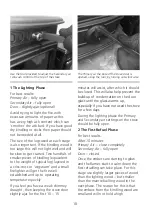
20
Getting the balance right between a
gently burning stove and one that is
burning too slow, creating smoke and
causing the Airwash to fail and
consequently the glass to stain is very
much a matter of trial and error. If you
are burning well-seasoned wood then
a quick ‘blast’ of the stove operating at
‘full throttle’, with Secondary and
Primary air fully open, should quickly
burn off any deposits left from any
slower burning phase.
4 Refuelling
For best results:
Just before you refuel –
Primary Air – fully open
Secondary Air – fully open
After loading and when new fuel is
burning well –
Primary Air – close completely
Secondary Air– adjust to suit
Regular, smaller loads are better
because they keep the firechamber at a
higher temperature, without over-firing
it. The higher operating temperature
helps prevent nuisance smoke and
sooty deposits.
Never overfill the firechamber and also
avoid over-sized pieces of wood which
will ‘slow’ the fire down at the start but
then could lead to over-firing.
Before refuelling open the Primary and
Secondary air supply so that there is a
good strong fire so that the embers are
glowing red which will help the new
fuel to start burning quickly. This will
also ensure that there is no build-up of
harmful gas which could be released
into the room when the firechamber
door is opened.
Rake the embers and spread them out
to make an even bed. You may need
to add some kindling to re-establish
the fire. Add the new wood as before
ensuring that the logs are not tightly
packed.
Newly refuelled wood always requires
some additional air so make sure the
Secondary air is back in the fully open
position after refuelling. Do not adjust
the Secondary air until the fire is
burning well and you can see bright
yellow vigorous flames. Once the fire is
established, usually after 5 minutes, close
the Primary air and adjust the flame
pattern again to your requirements with
the Secondary air (Airwash) control.
Refuelling on to a low firebed
When refuelling you must ensure that
there is a sufficient quantity of glowing
embers and ash so that the new fuel
charge will quickly ignite. Refuelling
on an inadequate bed of embers will
create excess smoke and will take
much longer. It is very much easier
and quicker to ‘start’ again by adding
a suitable quantity of kindling to the
remaining embers ensuring that there
are sufficient brightly burning flames
before medium sized logs are added.
IMPORTANT: Fuel overloading
The maximum amount of fuel specified
in this manual (see page 8) should not
be exceeded. Overloading can cause
excess smoke and is also dangerous.
Operating with the door open
This stove is not designed to be
operated with the door left open,
except as directed in these instructions.
This can cause excess smoke and can be
Summary of Contents for HF217-SE Baby Gabriel
Page 2: ......
Page 7: ...7 GENERAL DIMENSIONS 414 435 555 95 134 345 134 125 ø All dimensions are in mm ...
Page 43: ......
















































